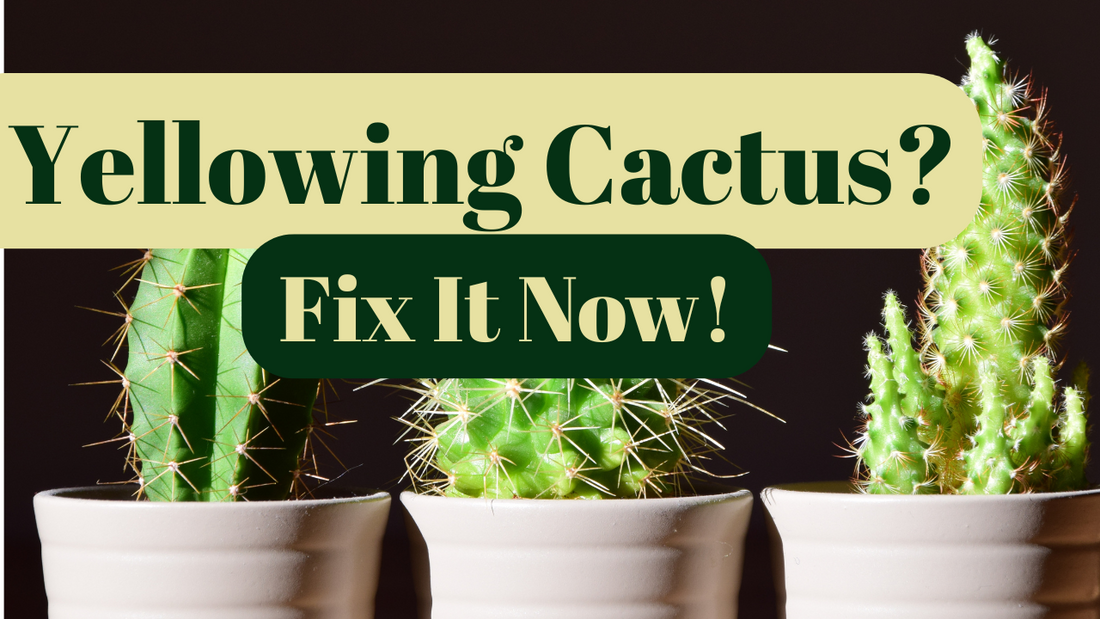
Why Is My Cactus Turning Yellow? Common Causes & Easy Fixes
Share
Introduction
Your cactus is supposed to be the low-maintenance hero of your plant collection. So when it starts turning yellow, it can be confusing and frustrating. Don't worry—yellowing is a common issue and usually reversible if you act quickly.
In this guide, we'll explore why cacti turn yellow, how to identify the root cause, and what you can do to bring your plant back to full health.
🌞 1. Overwatering and Root Rot
Overwatering is the #1 reason a cactus turns yellow. Unlike typical houseplants, cacti are built to thrive in dry environments. Too much water causes their roots to rot, making it impossible for the plant to absorb nutrients properly.
Signs of Overwatering:
-
Yellowing from the base up
-
Mushy or black roots
-
Foul odor from the soil
What To Do:
-
Remove the cactus from its pot and check the roots.
-
Trim off any black, mushy roots.
-
Let the plant dry for a day, then repot in well-draining cactus mix.
-
Cut back on watering—only water when the soil is bone-dry.
💡 Tip: Always use pots with drainage holes to avoid standing water.
🌵 2. Underwatering
Ironically, watering too little can also cause yellowing. If your cactus looks shriveled or yellow at the tips, it may be dehydrated.
What To Do:
-
Water thoroughly until water drains from the bottom.
-
Adjust your watering schedule based on the season. During warmer months, water every 2–4 weeks; in winter, every 4–6 weeks.
☀️ 3. Too Much or Too Little Light
Light is vital—but balance is key.
Too Much Light (Sunburn):
-
Yellow patches on the sunny side
-
Brittle or scorched appearance
Too Little Light (Etiolation):
-
Pale yellow color overall
-
Tall, stretched-out growth
What To Do:
-
Place your cactus in bright, indirect light—like a south- or east-facing window.
-
Avoid placing it in direct afternoon sun if it's not acclimated.
🪴 4. Wrong Soil Type
Regular potting soil retains too much moisture for cacti.
What To Use Instead:
-
Cactus/succulent-specific mix
-
Or mix your own with 1 part potting soil, 1 part perlite, and 1 part coarse sand
Repot every 1–2 years to refresh the soil and prevent compaction.
🧪 5. Nutrient Deficiency
Cacti don’t need a lot of fertilizer, but a deficiency—especially of nitrogen or magnesium—can cause yellowing.
What To Do:
-
Apply a diluted cactus fertilizer during the growing season (spring/summer)
-
Avoid fertilizing in the winter when growth slows
🐜 6. Pests and Insects
Common pests like mealybugs, spider mites, and aphids suck the nutrients from your plant, often leaving behind yellow or discolored spots.
Signs to Watch For:
-
Cottony white clumps (mealybugs)
-
Fine webbing (spider mites)
-
Sticky residue or tiny crawling insects
What To Do:
-
Isolate the affected plant
-
Treat with neem oil or insecticidal soap
-
Wipe down leaves and spines with a damp cloth
❄️ 7. Temperature Stress
Cacti prefer warm conditions. Sudden cold drafts or exposure to frost can damage the plant and cause it to turn yellow.
What To Do:
-
Keep your cactus in a room that stays above 50°F (10°C)
-
Avoid placing it near air conditioners or drafty windows
🔄 8. Transplant Shock
If you recently repotted your cactus, it might be in shock. This stress can cause temporary yellowing.
What To Do:
-
Give it time—avoid moving or fertilizing it for a few weeks
-
Ensure the new pot and soil are appropriate for cacti
🧰 Quick Fix Checklist
Here’s a fast reference for what to check:
| Problem | Solution |
|---|---|
| Overwatering | Let dry, repot in cactus mix |
| Underwatering | Water deeply, then adjust schedule |
| Too much/little light | Move to bright, indirect sunlight |
| Poor soil | Use fast-draining cactus mix |
| Nutrient issues | Fertilize with cactus-safe formula |
| Pests | Remove pests with neem oil or soap |
| Cold exposure | Keep in warm, draft-free space |
| Transplant shock | Be patient and limit disturbances |
📝 Summary
If your cactus is turning yellow, it’s a cry for help—but it’s not the end! By diagnosing the problem early—whether it’s too much water, not enough light, or a pest problem—you can take quick action to nurse your plant back to vibrant health.
🌿 Remember: Cactus care is about balance—give them what they need, and they’ll thrive with minimal fuss.
❓ FAQ
Q: Will my yellow cactus turn green again?
Yes, if the yellowing is from a fixable issue like overwatering or poor lighting, your cactus can bounce back.
Q: How do I know if my cactus is overwatered or underwatered?
Check the roots and texture. Mushy or black roots = overwatering. Wrinkled, dry appearance = underwatering.
Q: Can I save a cactus with root rot?
Yes, if caught early. Trim off rotted roots and repot in dry cactus soil.
🧠 More Garden Wrld Reads
📚 Sources
